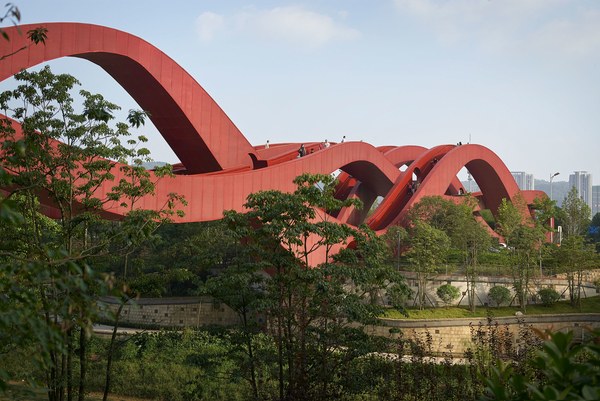China’s seemingly infinite Lucky Knot bridge, located in the Changsha Meixi Lake District and designed by Amsterdam-based Next Architects, arches and dips like a roller coaster—with good reason. The 600-foot-long steel structure, which is actually three bridges that interlock into one, needed to accommodate boat traffic (measuring at least 78 feet above water level) that passes through the Dragon King Harbor River while also remaining pedestrian-friendly with stairs that aren’t too steep. Five intersections provide structural support for the bridge, while strategically placed circular entrances, or “moon gates,” enable walkers to switch paths. “We refer to it as a Mobius ring,” says Next Architects partner Michel Schreinemachers. “It’s a never-ending shape.” [Wired]
Tobermorite, an organic crystalline counterpart of the calcium-silicate-hydrate that makes up cement, could be the key to a more flexible concrete because of its molecular structure. [Phys.org]
Merge VR debuts HoloCube at this year’s CES in Las Vegas, a seemingly ordinary foam cube that transforms into various virtual objects that users can touch and examine through virtual reality headsets. [New Atlas]
Ice plays a huge role in the collaborative concept design called “Mars Ice Home,” by NASA, Space Exploration Architecture, and Clouds Architecture Office. The proposal is an inflatable, doughnut-shaped structure that won the NASA Centennial Challenge. [NASA]
China has announced plans to invest 2.5 trillion yuan (about $361 billion) in order to make a substantial switch to renewable energy by the year 2020. [Reuters]
Tesla and Panasonic have officially begun production of lithium-ion batteries at their Gigafactory in Reno, Nev. [Tesla]
Using haptic feedback technology, Tanvas, a Chicago-based technology company, has created TanvasTouch—a new kind of touchpad screen that lets users feel the materials they are touching through electromagnetic pulses. [The Verge]
The Italian government is taking precautions to protect its most precious works of art and architecture by seeking funding from the European Commission. Italian architect Fernando De Simone is urging Florence’s city council to consider moving the city’s most valuable pieces into a more seismic-friendly structure. [The Art Newspaper]
